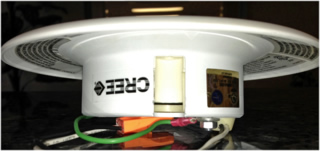Power Up - Page 4
 |
|
|
 |
|
|
Your roofing contractor will play a key role in ensuring that your electrical upgrades are hidden from view and protected from the elements. Once the new roof is in place, your electrical-upgrade options are then significantly reduced.
"When we come to a house, we will find electrical wires, gas lines, and water lines run across the roof, and they are not protected from penetrations the way they should be," says Sonny Rossi, owner of Cal-Pac Roofing, a single-ply roofing installer in San Mateo. "The overall rule is if you're doing extensive remodeling or construction, do the roof at the same time. The same goes for electrical."
Installing a single-ply roof over imbedded wiring sometimes presents challenges because the roofer doesn't always know what lies buried under the roofing material.
"We use a mechanical fastener system [for mounting the roofing material to the roof], so hidden wiring can cause us big problems if we don't know where it is," Rossi says. "If we hit a wire, we have to try to isolate the circuit and run a new wire. If we know about it in advance, it's quite simple to add boots around any penetration that the electrician may make in the roof."
Hiding electrical under a foam roof also requires advance planning, since spray-on foam takes on whatever shape it encapsulates. For example, the roofer may cut a trench in the roof, build a box to house the new electrical wiring, and then foam over the box. At times like this, a quality foam installer will also maintain aesthetics and positive drainage as priorities.
 |
 |
|
|
New lighting channels
If you want to add new lighting—including recessed, low-voltage, string, or track lights—the roofer will also need to work with the electrician on how to mask unsightly light boxes.
"We often see situations where someone cuts out a four-square-foot piece of roof to insert a one-square-foot piece of metal," says Randy Feriante, owner of Dura-Foam Solar Center, a foam installer based in Menlo Park. "There are better solutions."
To hide wiring, Feriante recommends building a small channel for the wire, and then encase the channel in foam.
For recessed lighting, he recommends a new low-profile LED disk light, made by Commercial Electric (CE-JB4-600L-27K-E26 - from Home Depot), which has a depth of only 2.75 inches. It can fit in tight spaces and meets Title 24 requirements.
"These LED fixtures have worked well in some of my recent Eichler projects," Feriante says. "They fit almost flush to the ceiling, with the base fitting inside most standard four-inch electrical boxes. Priced at around $40, the fixtures give off the same amount of light as a 65-watt bulb but consume only 12 watts."
Installing these lights for Feriante's project involved removing the old roof down to the ceiling planks. Foam boards were cut to fit around the electrical boxes holding the lights, which protrude about one inch through the ceiling. "The new foam," Feriante adds, "goes over everything, covering the ugly boxes that used to stick up on the roof."
Photos: David Toerge; and courtesy Dura-Foam Solar Center, Heidi Slocomb, Barry Brisco, Thomas Westfall
STORY RESOURCES
- « first
- ‹ previous
- 1
- 2
- 3
- 4




